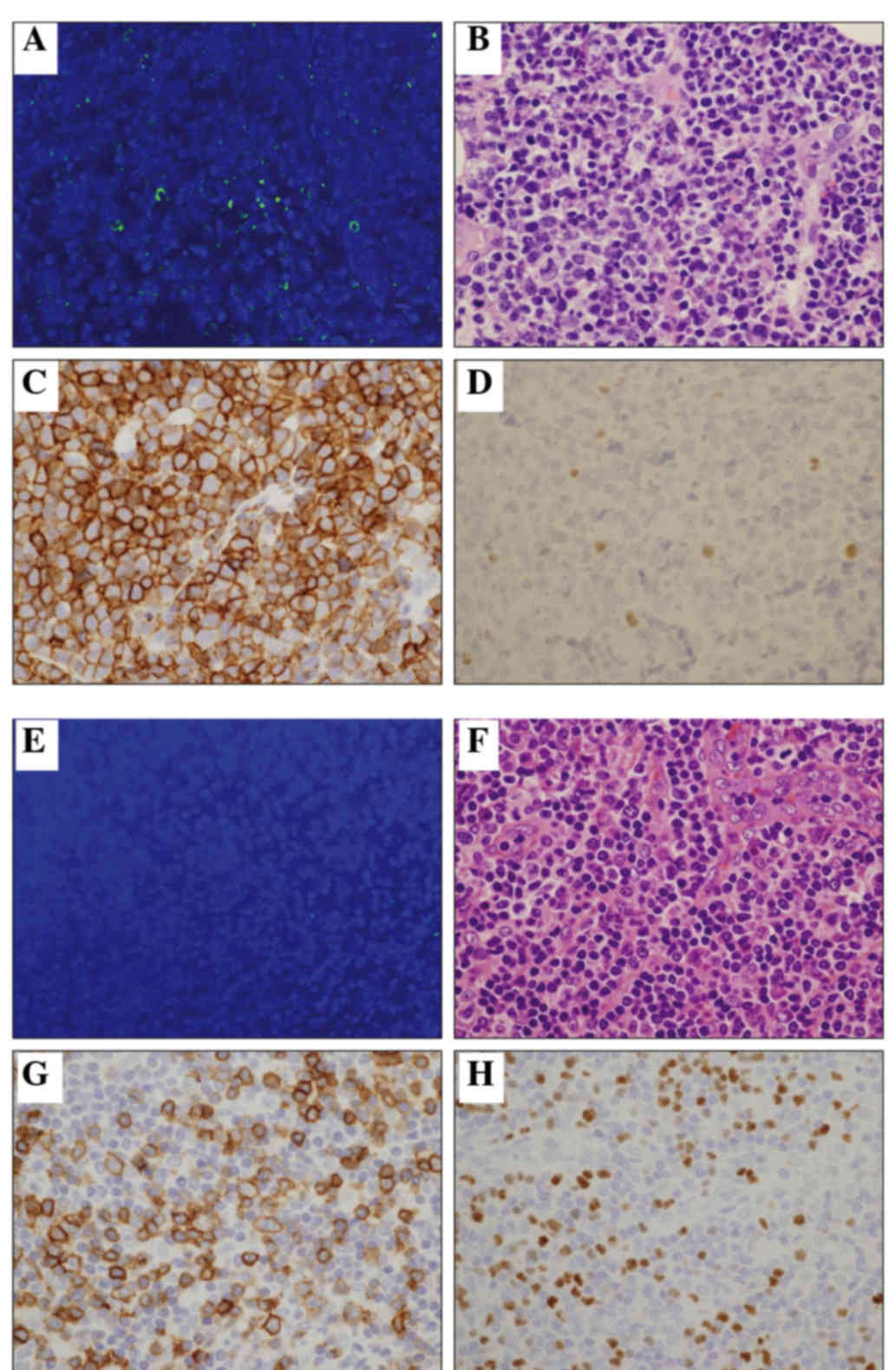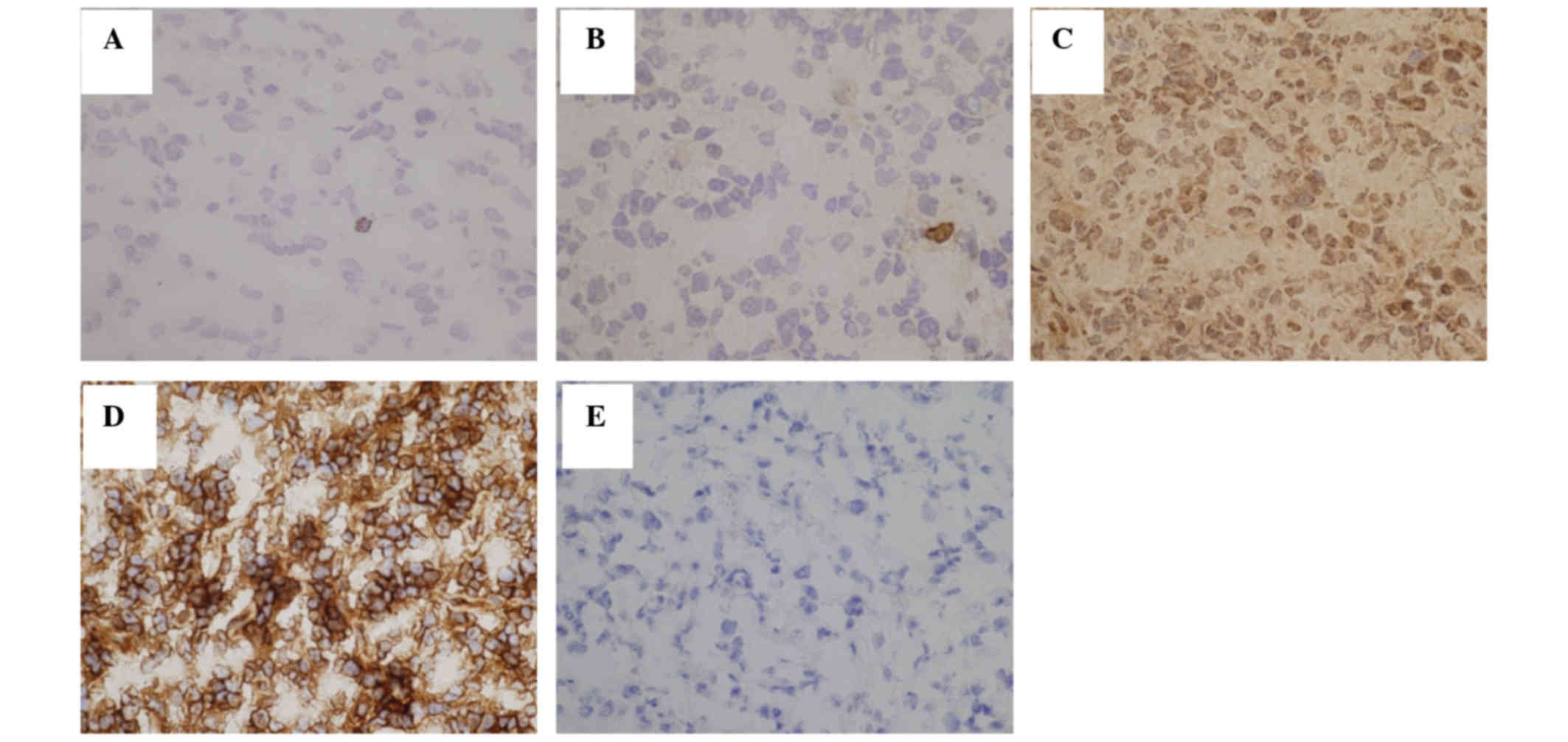|
1
|
Poiesz BJ, Ruscetti FW, Gazdar AF, Bunn
PA, Minna JD and Gallo RC: Detection and isolation of type C
retrovirus particles from fresh and cultured lymphocytes of a
patient with cutaneous T-cell lymphoma. Proc Natl Acad Sci USA.
77:pp. 7415–7419. 1980; View Article : Google Scholar : PubMed/NCBI
|
|
2
|
Verdonck K, González E, van Dooren S,
Vandamme AM, Vanham G and Gotuzzo E: Human T-lymphotropic virus 1:
Recent knowledge about an ancient infection. Lancet Infect Dis.
7:266–281. 2007. View Article : Google Scholar : PubMed/NCBI
|
|
3
|
Gessain A: Epidemiology of HTLV-1 and
associated diseaseHuman T-cell Lymphotropic Virus Type-1. Hollsberg
P and Hafler DA: Wiley; Chichister: pp. 33–64. 1996
|
|
4
|
Tobinai K: Current management of adult
T-cell leukemia/lymphoma. Oncology (Williston Park). 23:1250–1256.
2009.PubMed/NCBI
|
|
5
|
Swerdlow SH, Campo E, Harris NL, Jaffe ES,
Pileri SA, Stein H, Thiele J and Vardiman JW: WHO Classification of
Tumours of Haematopoietic and Lymphoid Tissues. 2. 4th. IARC Press;
Lyon, France: 2008
|
|
6
|
Karube K, Aoki R, Sugita Y, Yoshida S,
Nomura Y, Shimizu K, Kimura Y, Hashikawa K, Takeshita M, Suzumiya
J, et al: The relationship of Foxp3 expression and
clinicopathological characteristics in adult T-cell
leukemia/lymphoma. Mod Pathol. 21:617–625. 2008. View Article : Google Scholar : PubMed/NCBI
|
|
7
|
Yano H, Ishida T, Inagaki A, Ishii T,
Kusumoto S, Komatsu H, Iida S, Utsunomiya A and Ueda R: Regulatory
T-cell function of adult T-cell leukemia/lymphoma cells. Int J
Cancer. 120:2052–2057. 2007. View Article : Google Scholar : PubMed/NCBI
|
|
8
|
Marsh BJ: Infectious complication of Human
T cell leukemia/lymphoma virus type I infection. Clin Infect Dis.
23:138–145. 1996. View Article : Google Scholar : PubMed/NCBI
|
|
9
|
Montes M, Sanchez C, Verdonck K, Lake JE,
Gonzalez E, Lopez G, Terashima A, Nolan T, Lewis DE, Gotuzzo E and
White AC Jr: Regulatory T cell expansion in HTLV-1 and
strongyloidiasis co-infection is associated with reduced IL-5
responses to strongyloides stercoralis antigen. PLoS Negl Trop Dis.
3:e4562009. View Article : Google Scholar : PubMed/NCBI
|
|
10
|
Marcos LA, Terashima A, Dupont HL and
Gotuzzo E: Strongyloides hyperinfection syndrome: An emerging
global infectious disease. Trans R Soc Trop Med Hyg. 2:314–318.
2008. View Article : Google Scholar
|
|
11
|
Sakaguchi S, Wing K, Onishi Y,
Prieto-Martin P and Yamaguchi T: Regulatory T cells: How do they
suppress immune responses? Int Immunol. 21:1105–1111. 2009.
View Article : Google Scholar : PubMed/NCBI
|
|
12
|
Suzuki S, Masaki A, Ishida T, Ito A, Mori
F, Sato F, Narita T, Ri M, Kusumoto S, Komatsu H, et al: Tax is a
potential molecular target for immunotherapy of adult T-cell
leukemia/lymphoma. Cancer Sci. 3:1764–1773. 2012. View Article : Google Scholar
|
|
13
|
Seiki M, Hattori S, Hirayama Y and Yoshida
M: Human adult T-cell leukemia virus: Complete nucleotide sequence
of the provirus genome integrated in leukemia cell DNA. Proc Natl
Acad Sci USA. 80:pp. 3618–3622. 1983; View Article : Google Scholar : PubMed/NCBI
|
|
14
|
Franchini G: Molecular mechanisms of human
T-cell leukemia/lymphotropic virus type I infection. Blood.
86:3619–3639. 1995.PubMed/NCBI
|
|
15
|
Jin DY, Spencer F and Jeang KT: Human T
cell leukemia virus type 1 oncoprotein Tax targets the human
mitotic checkpoint protein MAD1. Cell. 93:81–91. 1998. View Article : Google Scholar : PubMed/NCBI
|
|
16
|
Grossman WJ, Kimata JT, Wong FH, Zutter M,
Ley TJ and Ratner L: Development of leukemia in mice transgenic for
the Tax gene of human T-cell leukemia virus type I. Proc Natl Acad
Sci USA. 92:pp. 1057–1061. 1995; View Article : Google Scholar : PubMed/NCBI
|
|
17
|
Kannagi M: Immunologic control of human
T-Cell leukemia virus type I and adult T-cell leukemia. Int J
Hematol. 86:113–117. 2007. View Article : Google Scholar : PubMed/NCBI
|
|
18
|
Takeda S, Maeda M, Morikawa S, Taniguchi
Y, Yasunaga J, Nosaka K, Tanaka Y and Matsuoka M: Genetic and
epigenetic inactivation of Tax gene in adult T-cell leukemia cells.
Int J Cancer. 109:559–567. 2004. View Article : Google Scholar : PubMed/NCBI
|
|
19
|
Seliger B, Cabrera T, Garrido F and
Ferrone S: HLA class I antigen abnormalities and immune escape by
malignant cells. Semin Cancer Biol. 12:3–13. 2002. View Article : Google Scholar : PubMed/NCBI
|
|
20
|
Shimauchi T, Kabashima K and Tokura Y:
Adult T-cell leukemia/lymphoma cells from blood and skin tumors
express cytotoxic T lymphocyte-associated antigen-4 and Foxp3 but
lack suppressor activity toward autologous CD8+ T cells. Cancer
Sci. 9:98–106. 2008.
|
|
21
|
Toulza F, Nosaka K, Takiguchi M, Pagliuca
T, Mitsuya H, Tanaka Y, Taylor GP and Bangham CR: Foxp3+ regulatory
T cells are distinct from leukemia cells in HTLV-1-associated adult
T-cell leukemia. Int J Cancer. 5:2375–2382. 2009. View Article : Google Scholar
|
|
22
|
Little AM and Parham P: Polymorphism and
evolution of HLA class I and II genes and molecules. Rev
Immunogenet. 1:105–123. 1999.PubMed/NCBI
|
|
23
|
Satou Y, Yasunaga J, Yoshida M and
Matsuoka M: HTLV-1 basic leucine zipper factor gene mRNA supports
proliferation of adult T cell leukemia cells. Proc Natl Acad Sci
USA. 103:pp. 720–725. 2006; View Article : Google Scholar : PubMed/NCBI
|
|
24
|
Andersen MH, Pedersen LO, Capeller B,
Bröcker EB, Becker JC and Straten P thor: Spontaneous cytotoxic
T-cell responses against survivin-derived MHC class I-restricted
T-cell epitopes in situ as well as ex vivo in cancer patients.
Cancer Res. 16:5964–5968. 2001.
|
|
25
|
Schrama D, Pedersen LØ, Keikavoussi P,
Andersen MH, Straten Pt, Bröcker EB, Kämpgen E and Becker JC:
Aggregation of antigen-specific T cells at the inoculation site of
mature dendritic cells. J Invest Dermatol. 9:1443–1448. 2002.
View Article : Google Scholar
|
|
26
|
Harashima N, Kurihara K, Utsunomiya A,
Tanosaki R, Hanabuchi S, Masuda M, Ohashi T, Fukui F, Hasegawa A,
Masuda T, et al: Graft-versus-Tax response in adult T-cell leukemia
patients after hematopoietic stem cell transplantation. Cancer Res.
64:391–399. 2004. View Article : Google Scholar : PubMed/NCBI
|
|
27
|
Ohashi T, Hanabuchi S, Suzuki R, Kato H,
Masuda T and Kannagi M: Correlation of major histocompatibility
complex class I downregulation with resistance of human T-cell
leukemia virus type 1-infected T cells to cytotoxic T-lymphocyte
killing in a rat model. J Virol. 76:7010–7019. 2002. View Article : Google Scholar : PubMed/NCBI
|
|
28
|
Yamamoto K, Utsunomiya A, Tobinai K,
Tsukasaki K, Uike N, Uozumi K, Yamaguchi K, Yamada Y, Hanada S,
Tamura K, et al: Phase I study of KW-0761, a defucosylated
humanized anti-CCR4 antibody, in relapsed patients with adult
T-cell leukemia-lymphoma and peripheral T-cell lymphoma. J Clin
Oncol. 28:1591–1598. 2010. View Article : Google Scholar : PubMed/NCBI
|
|
29
|
Tobinai K, Takahashi T and Akinaga S:
Targeting chemokine receptor CCR4 in adult T-cell leukemia/lymphoma
and other T-cell lymphomas. Curr Hematol Malig Rep. 7:235–240.
2012. View Article : Google Scholar : PubMed/NCBI
|
|
30
|
Kono K: Current status of cancer
immunotherapy. J Stem Cells Regen Med. 30:8–13. 2014.
|
|
31
|
Tosti G, Cocorocchio E and Pennacchioli E:
Anti-cytotoxic T lymphocyte antigen-4 antibodies in melanoma. Clin
Cosmet Investig Dermatol. 6:245–256. 2013.PubMed/NCBI
|
|
32
|
Chambers CA, Kuhns MS, Egen JG and Allison
JP: CTLA-4-mediated inhibition in regulation of T cell responses:
mechanisms and manipulation in tumor immunotherapy. Annu Rev
Immunol. 19:565–594. 2001. View Article : Google Scholar : PubMed/NCBI
|
|
33
|
Parekh VV, Lalani S, Kim S, Halder R,
Azuma M, Yagita H, Kumar V, Wu L and Kaer LV: PD-1/PD-L blockade
prevents anergy induction and enhances the anti-tumor activities of
glycolipid-activated invariant NKT cells. J Immunol. 182:2816–2826.
2009. View Article : Google Scholar : PubMed/NCBI
|
|
34
|
Andersen MH, Schrama D, Straten P Thor and
Becker JC: Cytotoxic T cells. J Invest Dermatol. 126:32–41. 2006.
View Article : Google Scholar : PubMed/NCBI
|
|
35
|
Seliger B, Ritz U and Ferrone S: Molecular
mechanisms of HLA class I antigen abnormalities following viral
infection and transformation. Int J Cancer. 118:129–138. 2006.
View Article : Google Scholar : PubMed/NCBI
|
|
36
|
Johnson JM, Nicot C, Fullen J, Ciminale V,
Casareto L, Mulloy JC, Jacobson S and Franchini G: Free major
histocompatibility complex class I heavy chain is preferentially
targeted for degradation by human T-cell leukemia/lymphotropic
virus type 1 p12I protein. J Virol. 75:6086–6094. 2001. View Article : Google Scholar : PubMed/NCBI
|
|
37
|
Francke U and Pellegrino MA: Assignment of
the major histocompatibility complex to aregion of the short arm of
human chromosome 6. Proc Natl Acad Sci USA. 74:pp. 1147–1151. 1977;
View Article : Google Scholar : PubMed/NCBI
|
|
38
|
Richardson JH, Edwards AJ, Cruickshank JK,
Rudge P and Dalgleish AG: In vivo cellular tropism of human T-cell
leukemia virus type 1. J Virol. 64:5682–5687. 1990.PubMed/NCBI
|














